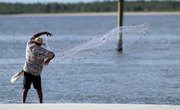True minnows come from the family Cyprinidae, which is made up of over 2,400 species around the world. Colloquially, the term minnow has come to refer to any young fish, especially those used as fishing bait. As fishing is popular as both a pastime and an industry in Florida, minnows abound in bait shops, with the same species often being called many different names. Bait minnows are sold live, which is the most common choice for anglers looking to attract fish, and also frozen.
Gulf Killifish (Fundulus grandis)
The Gulf killifish has any number of nicknames, including bull minnow, which is the most popular, finger minnow, mud minnow, cacahoe, chub and mudfish. Regardless of what they call it, flounder anglers swear by the killifish, as it is the flounder's preferred forage food. The killifish is extremely hardy and able to survive conditions with low oxygen and high temperatures, which is the atmosphere of most bait buckets. This minnow is an important player in the southeast bait lineup of saltwater anglers and is used for catching snapper and black sea bass in addition to flounder. Mainly found in the bait shops of northern Florida, the killifish can be caught in creeks and marshes using minnow traps.
Golden Shiner (Notemigonus chrysoleucas)
Golden shiners, which are actually a reddish-gold color instead of purely gold, are prized bait by Florida anglers looking to catch bass. They are not the most ideal bait minnow ,as their fragile scales are quick to come off, but they are one of the most popular due to their ability to attract a nice-sized bass. At their longest, golden shiners can grow to around 1 foot, which is enough to provide a satisfying meal for a largemouth bass. Largemouth bass are found in lakes all over the state and are often caught using golden shiners that are farmed locally.
Green Sailfin Mollies (Poecilia velifera)
Sailfin mollies are a versatile minnow because they thrive in both saltwater and freshwater environments; they are commonly found in aquariums and bait shops. The sailfin molly's top and mid-level dwelling habits ensure that when a fish comes along, it won't dart to the bottom to try and hide. Both of these traits are useful for anglers who want their live bait to stay healthy in the bucket and then attract a fish once hooked and cast. Regulations surrounding the sailfin molly change frequently and in some areas they require a permit to be used for fishing, so check state and county regulations before loading up the bait bucket.
References
Writer Bio
Elizabeth Stewart has been writing and editing since 2000. Her articles appear on eHow, where she specializes in writing about education and travel. She also works as an editorial consultant for novelists. Stewart holds a Bachelor of Arts in English from Millsaps College and a Master of Arts in international education.



